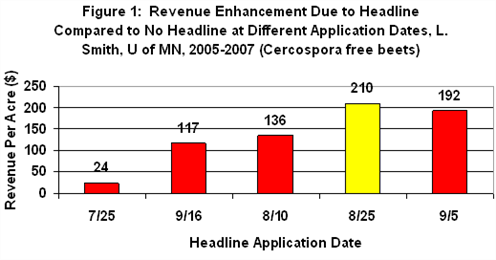513 - N Management, Crop Rotation, Plant Health
It's hard to believe the 2008 growing season is nearing pre-pile harvest. Planning for 2009 is already underway with major considerations being 1) field selection 2) previous crop concerns 3) managing very high cost fertilizers 4) and analyzing need for every tillage operation just to name a few. Cost of fertilizer required to produce sugarbeets has increased from $23/A in 2004 to $81/A in 2008. Best management practice fertilizer use is critical to maximum crop yields. Every effort must be made to maximize efficient use of N, P, & K at the lowest cost without sacrificing yield.
Zone Soil Testing and Variable Rate N Application
Data in Table 1 documents the value of zone fertility management. Soil testing zones can be established in a variety of ways including:
- Previous beet top imagery maps
- Topography maps
- Yield maps
- A combination of these maps
Zone sampling and variable rate N application increased RSA by 252 lbs. and revenue per acre by $36/year over the past 5 years - Table 1. Contact your agriculturist or crop consultant for assistance with a zone management program. As little as 10 lbs./A variability between zones justifies variable rate spreading of high cost nitrogen. Zone management primarily increases crop yield. Choosing the proper application rates for each zone improves crop quality.
Table 1. Effect of Zone Fertility Management on Yield, 2003-2007 ACSC Database
| Management Method | Yield Factor | Revenue/Acre ($) | |
|---|---|---|---|
| RSA (lbs) | (RST (lbs) | ||
| Zone | 7567 | 388 | 1022 |
| Conventional | 7315 | 338 | 986 |
| Zone Advantage | 252 | 0 | 36 |
Headline for Plant Health
Growers are definitely encouraged to apply Headline 30 to 40 days prior to harvest on EVERY acre. This practice is strongly supported by research by Dr. Larry Smith at the NWROC - U of MN and similar research in Idaho and Europe. Figure 1 shows the revenue increase due to timely Headline application.

Crop Rotation and Field Selection for 2009
Preceeding crop effects do impact sugarbeet growth and profitability in many ways. Previous crop effects on sugarbeet production may include:
- Different tillage costs
- Increase or decrease in disease
- Herbicide carryover risk
- Residual nitrate - N level
- Ease of seedbed preparation
- Wind erosion and stand loss risk
- Stored soil water for 2009
- Weed species and competition
Dr. Albert Sims, U of MN, NWROC soil scientist's research has shown that it is more difficult to maximize sugarbeet yields following corn than when following wheat or other crops. Figure 2 shows the yield of sugarbeets following different crops in rotation. Corn had the lowest RSA and RST of any previous crop. Growers will need to manage beets after corn very carefully to maximize profitability.

Previous crop had almost no effect on stand count at harvest. Yield differences were due to other factors like available water, weed control, fertility differences or possibly allelopathy.
